| |
GULLS Larinae |
- 52 species worldwide
- DR personal total: 41 species (79%), 36 photo'd
|
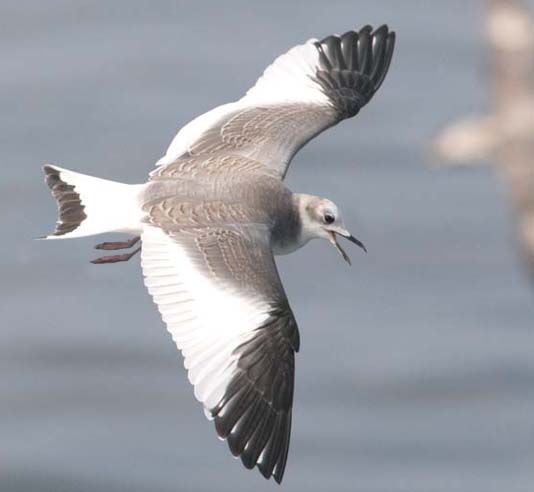 Gulls
are ubiquitous denizens of temperate shorelines around the world. Many
species are large and conspicuous and everyone in the northern
hemisphere can recognize a "gull," even if they think they are boring
(flock of California Gull, above). Only birders
realize that gulls are extremely complex and interesting. Larger
species take four or more years to mature and molt twice a year (one
complete molt, one partial molt for most species), so there are thus at
least 8 plumages (including the briefly worn juvenal plumage) to learn,
not to mention the effect of wear or albinism. Gulls
are ubiquitous denizens of temperate shorelines around the world. Many
species are large and conspicuous and everyone in the northern
hemisphere can recognize a "gull," even if they think they are boring
(flock of California Gull, above). Only birders
realize that gulls are extremely complex and interesting. Larger
species take four or more years to mature and molt twice a year (one
complete molt, one partial molt for most species), so there are thus at
least 8 plumages (including the briefly worn juvenal plumage) to learn,
not to mention the effect of wear or albinism.
There are graceful and exceptionally beautiful gulls, like the sea-going Sabine's Gull
(left; in juvenal plumage, attracted to our boat on Monterey Bay). It
breeds high in the Arctic, then migrates far offshore to wintering
grounds in the southern hemisphere. |
 Another lovely and specialized gull is the tundra-breeding Ross's Gull
(right; an adult). This delicate beauty, lightly flushed with pink in
summer, is a highly sought-after prize. This is particularly true when
it wanders south in winter and appears as a vagrant is such unexpected
places as coastal Massachusetts, or Chicago, Illinois. One eventually
reached California in Nov 2006 — at the Salton Sea, no less! — where
many eager birders enjoyed it, but my chase trip was a few hours too
late. Another lovely and specialized gull is the tundra-breeding Ross's Gull
(right; an adult). This delicate beauty, lightly flushed with pink in
summer, is a highly sought-after prize. This is particularly true when
it wanders south in winter and appears as a vagrant is such unexpected
places as coastal Massachusetts, or Chicago, Illinois. One eventually
reached California in Nov 2006 — at the Salton Sea, no less! — where
many eager birders enjoyed it, but my chase trip was a few hours too
late.
The potential for vagrancy and the complexity
of plumages has spawned an intense interest in gulls in recent years.
Hybridization and introgression among large larids further complicates
matters, intriguing some and disgusting others. Information continues
to accumulate at a rapid pace, some of it available on-line (see
below). |
|
We
are also learning that gull populations in North America are rapidly
expanding as gulls adapt to a human-altered landscape. They eat our
garbage, and visit our garbage dumps, and the building of large
reservoirs in the interior has led to range expansion (e.g., Binford
& Johnson 1995). One interesting finding from the Monterey County
Breeding Bird Atlas project (Roberson & Tenney 1993) is that the
common local breeding species (Western Gull, above: a
calling adult and a chick ) has moved much of its nesting population
from pristine islets on the Big Sur coast to man-made objects around
Monterey Bay. To further illustrate the ubiquity of gulls, here's a
small collage of Larus gull species from around the world: |
|
This collage represented:
- Top: a sandy beach at Fujairah, United Arab Emirates, on the Persian Gulf: the large gulls are (L to R) Siberian Gull Larus heuglini (with dark mantle) and two Yellow-legged Gull L. cachinnans; the small gulls with dark ear-spots are Black-headed Gull L. ridibundus in basic plumage, and the long-billed small gull without an ear-spot is Slender-billed Gull L. genei. [There is also one White-cheeked Tern Sterna repressa.]
- Upper left: gull colony at Bird Island, Qinghai Lake, north-central China: mostly Brown-headed Gull L. brunnicephalus and one large Pallas's Gull L. ichthyaetus
- Upper right, park on Texel I., Netherlands: juvenal-plumaged Lesser Black-backed Gull L. fuscus
- Bottom left: juvenal-plumaged Silver Gull L. novaehollandiae on Heron I. in the Great Barrier Reef, Australia
- Bottom right: adult Thayer's Gull L. thayeri at Moss Landing, Monterey Co., California
|
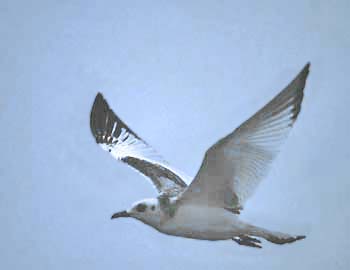 One
of the most unusual gulls is the night-feeding Swallow-tailed Gull
(left; a first-year bird) of the Galapagos. It feeds primarily on
spawning squid (Belopolsky & Tsigankova 1985); note the black
eye-patch on the young bird (right) that is an adaptation for night
feeding (see Hailman 1964). We are only now learning that worldwide
climactic events, particularly irregular and major El Niños,
significant impact distribution in southern and tropical species.
During the great El Niño of 1982-83, for example, warm water
washed over the Peru Current and oceanic productivity dropped to nil.
All Swallow-tailed Gulls were dispersed (Alival et al. 1983), some
reaching to 42°S off Chile (Peter Harrison, in litt.) and another showing up in Panama (Reed 1988). Some must have dispersed far to west and north. One
of the most unusual gulls is the night-feeding Swallow-tailed Gull
(left; a first-year bird) of the Galapagos. It feeds primarily on
spawning squid (Belopolsky & Tsigankova 1985); note the black
eye-patch on the young bird (right) that is an adaptation for night
feeding (see Hailman 1964). We are only now learning that worldwide
climactic events, particularly irregular and major El Niños,
significant impact distribution in southern and tropical species.
During the great El Niño of 1982-83, for example, warm water
washed over the Peru Current and oceanic productivity dropped to nil.
All Swallow-tailed Gulls were dispersed (Alival et al. 1983), some
reaching to 42°S off Chile (Peter Harrison, in litt.) and another showing up in Panama (Reed 1988). Some must have dispersed far to west and north.
|
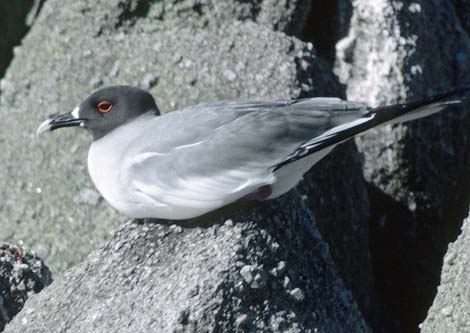 In
June 1985, as post-El Niño productivity returned, one such adult
made landfall at the nearest seabird colony and began engaging in
routine breeding behaviors, such as extensive foot-staring (see Hailman
1965). The rocky gull colony chosen by this adult Swallow-tailed Gull
was on the shores of Monterey Bay in my home town (Pacific Grove). What
a fantastic vagrant! Yet, for reasons more impacted by "philosophy" and
personalities than science, this long-distance migrant was considered
controversial because there were no "intervening" records, and it was
eventually rejected on "natural occurrence questionable" grounds by
records committees. This led to published comments that it was
"presumably a ship-assisted bird" (Burger & Gochfeld 1996), a
position at odds with the behavior of this species and without any
evidentiary support (see Hailman 1964, Snow & Snow 1968, Harris
1970; my analysis during the California committee review back in the
1980s is reproduced here).
Subsequently, another Swallow-tailed Gull appeared off California
during the El Niño of the mid-1990s and it was unanimously
accepted. The records committees finally re-reviewed the 1985 bird, and
accepted it retroactively, some 15 years (CBRC) and 21 years (ABA)
later. In
June 1985, as post-El Niño productivity returned, one such adult
made landfall at the nearest seabird colony and began engaging in
routine breeding behaviors, such as extensive foot-staring (see Hailman
1965). The rocky gull colony chosen by this adult Swallow-tailed Gull
was on the shores of Monterey Bay in my home town (Pacific Grove). What
a fantastic vagrant! Yet, for reasons more impacted by "philosophy" and
personalities than science, this long-distance migrant was considered
controversial because there were no "intervening" records, and it was
eventually rejected on "natural occurrence questionable" grounds by
records committees. This led to published comments that it was
"presumably a ship-assisted bird" (Burger & Gochfeld 1996), a
position at odds with the behavior of this species and without any
evidentiary support (see Hailman 1964, Snow & Snow 1968, Harris
1970; my analysis during the California committee review back in the
1980s is reproduced here).
Subsequently, another Swallow-tailed Gull appeared off California
during the El Niño of the mid-1990s and it was unanimously
accepted. The records committees finally re-reviewed the 1985 bird, and
accepted it retroactively, some 15 years (CBRC) and 21 years (ABA)
later. |
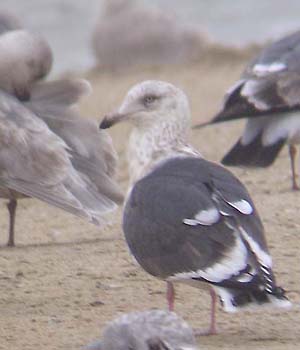 The
search for vagrant gulls consumes "gulliphiles" and sometimes even more
ordinary birdwatchers. By 2004, the hunt was on for such vagrants to
North America as Slaty-backed Gull (right). There is now much information available on-line. Some important specialty gull identification sites are: The
search for vagrant gulls consumes "gulliphiles" and sometimes even more
ordinary birdwatchers. By 2004, the hunt was on for such vagrants to
North America as Slaty-backed Gull (right). There is now much information available on-line. Some important specialty gull identification sites are:
Some years ago I found a Glaucous-winged Gull Larus glaucescens
in Nebraska — a first state record — during a freak April blizzard. A
paper reporting this record (Roberson & Carratello 1996) is
reproduced here.
|
Photos: The flock of (mostly) California Gull Larus californicus was on Carmel River beach, California, on 24 Feb 2004. The juvenal Sabine's Gull Xema sabini was on Monterey Bay on 28 Oct 2007. The adult Ross's Gull Rhodostethia rosea was at Churchill, Manitoba, Canada, in June 1988. The Western Gull Larus occidentalis
nesting birds (adult; chick) were at Moss Landing harbor, California,
in June 2005. The gulls in the collage were at Fujairah, Oman, in Mar
2001; on Texel, Netherlands, in Oct 1991; at Qinghai Lake, China, on 18
June 2004; on Heron Is., Australia, on 25 Nov 1983, and in Moss Landing
on 8 Jan 2004. The first-basic Swallow-tailed Gull Creagrus furcatus
was a hundred miles off Ecuador at about 3°S, 82°W, on 29 Sep
1989; Peter LaTourrette photographed the adult Swallow-tailed Gull at
Hopkins Marine Station, Pacific Grove, California, on 7 June 1985. The
3rd-cycle Slaty-backed Gull Larus schistisagus was at Half Moon Bay, San Mateo Co., California, on 21 Jan 2004. All photos © D. Roberson, except the adult Swallow-tailed Gull © Peter LaTourrette, used with permission; all rights reserved.
Bibliographic note:
There is no "subfamily book" per se but there are books covering
identification of northern hemisphere species, including the classic
volumes by Peter Grant (1982, 1986). Olson & Larssen (2004) is the
current state-of-the-art; Dunn & Howell (2007) is a competitor but
a dense read (some nice photos, though). The literature is full of
reference works on gulls. For example, the problematic Thayer's/Iceland
identification situation is covered nicely by Lehman (1980), Zimmer
(1990), and Zimmer (1991), among others.
Literature cited:
Alival,
A., Fuenzalida, R., Herrera, G., Prado, L., Soto, R., and Zapata, B.
1983. Presencia del fenómeno "El Niño" en la zona costera
de Iquique, con especial referncia al period 1982-1983. Amb. y Des.
1:133-136 [in Spanish, with English summary].
Anthony, A.W. 1895. Probable occurrence of Creagrus furcata off San Diego, California. Auk 12:291.
Belopolsky, L.O., and Tsigankova, Z. K. 1985. New data on the ecology
of the Galapagos Swallow-tailed Gull. Vestnik Zool. 1985:76-77 [In
Russian, translation by V. Volmensky].
Binford,
L.C., and D.B. Johnson. 1995. Range expansion of the Glaucous-winged
Gull into interior United States and Canada. Western Birds 26: 169-188.
Burger, J., and M. Gochfeld. 1996. Family Laridae (Gulls) in del Hoyo, J., Elliott, A., & Sargatal, J., eds. Handbook of the Birds of the World. Vol. 3. Lynx Edicions, Barcelona.
Dunn, J., and S.N.G. Howell. 2007. Gulls of the Americas (Peterson Reference Guides). Houghton Miflin, Boston.
Grant, P. J. 1982. Gulls: an Identification Guide. 1st ed. T. & A.D. Poyser, Stratfordshire, England.
Grant,
P. J. 1986. Gulls: an Identification Guide. 2d ed. T. & A.D.
Poyser, Stratfordshire, England, and Buteo Books, Vermillion, S. D.
Hailman, J.P. 1964. The Galapagos Swallow-tailed Gull is nocturnal. Wilson Bull. 76:347-354.
Hailman, J.P. 1965. Cliff-nesting adaptations of the Galapagos Swallow-tailed Gull. Wilson Bull. 77: 346-362.
Harris, M.P. 1970. Breeding ecology of the Swallow-tailed Gull, Creagrus furcatus. Auk 87: 215-243.
Lehman, P.E. 1980. The identification of Thayer's Gull in the field. Birding 12: 198-210.
Olsen, K.M., and H. Larsson. 2004. Gulls of North America, Europe, and Asia. Princeton Univ. Press, Princeton, N.J.
Reed, J.R. 1988. Inca Terns in the Bay of Panama during the 1982-1983 El Niño event. Am. Birds 42:172-173.
Roberson, D., and R. Carratello. 1996. First record of the Glaucous-winged Gull for Nebraska. Nebraska Bird Review 64: 3-4.
Roberson, D., and C. Tenney, eds. 1993. The Atlas of the Breeding Birds
of Monterey County, California. Monterey Pen. Audubon Soc., Carmel, CA.
Snow, B. K., and D.W. Snow. 1968. Breeding behavior of the Swallow-tailed Gull of the Galapagos. Condor 70:252-264.
Zimmer, K.J. 1990. "The Thayer's Gull complex," pp. 114-130 in Field
Guide to Advanced Birding by K. Kaufman. Houghton Mifflin, Boston.
Zimmer, K.J. 1991. Plumage variation in "Kumlien's" Iceland Gull. Birding 23: 254-269.
|
|
|


 In
June 1985, as post-El Niño productivity returned, one such adult
made landfall at the nearest seabird colony and began engaging in
routine breeding behaviors, such as extensive foot-staring (see Hailman
1965). The rocky gull colony chosen by this adult Swallow-tailed Gull
was on the shores of Monterey Bay in my home town (Pacific Grove). What
a fantastic vagrant! Yet, for reasons more impacted by "philosophy" and
personalities than science, this long-distance migrant was considered
controversial because there were no "intervening" records, and it was
eventually rejected on "natural occurrence questionable" grounds by
records committees. This led to published comments that it was
"presumably a ship-assisted bird" (Burger & Gochfeld 1996), a
position at odds with the behavior of this species and without any
evidentiary support (see Hailman 1964, Snow & Snow 1968, Harris
1970; my analysis during the California committee review back in the
1980s is reproduced here).
Subsequently, another Swallow-tailed Gull appeared off California
during the El Niño of the mid-1990s and it was unanimously
accepted. The records committees finally re-reviewed the 1985 bird, and
accepted it retroactively, some 15 years (CBRC) and 21 years (ABA)
later.
In
June 1985, as post-El Niño productivity returned, one such adult
made landfall at the nearest seabird colony and began engaging in
routine breeding behaviors, such as extensive foot-staring (see Hailman
1965). The rocky gull colony chosen by this adult Swallow-tailed Gull
was on the shores of Monterey Bay in my home town (Pacific Grove). What
a fantastic vagrant! Yet, for reasons more impacted by "philosophy" and
personalities than science, this long-distance migrant was considered
controversial because there were no "intervening" records, and it was
eventually rejected on "natural occurrence questionable" grounds by
records committees. This led to published comments that it was
"presumably a ship-assisted bird" (Burger & Gochfeld 1996), a
position at odds with the behavior of this species and without any
evidentiary support (see Hailman 1964, Snow & Snow 1968, Harris
1970; my analysis during the California committee review back in the
1980s is reproduced here).
Subsequently, another Swallow-tailed Gull appeared off California
during the El Niño of the mid-1990s and it was unanimously
accepted. The records committees finally re-reviewed the 1985 bird, and
accepted it retroactively, some 15 years (CBRC) and 21 years (ABA)
later. Gulls
are ubiquitous denizens of temperate shorelines around the world. Many
species are large and conspicuous and everyone in the northern
hemisphere can recognize a "gull," even if they think they are boring
(flock of California Gull, above). Only birders
realize that gulls are extremely complex and interesting. Larger
species take four or more years to mature and molt twice a year (one
complete molt, one partial molt for most species), so there are thus at
least 8 plumages (including the briefly worn juvenal plumage) to learn,
not to mention the effect of wear or albinism.
Gulls
are ubiquitous denizens of temperate shorelines around the world. Many
species are large and conspicuous and everyone in the northern
hemisphere can recognize a "gull," even if they think they are boring
(flock of California Gull, above). Only birders
realize that gulls are extremely complex and interesting. Larger
species take four or more years to mature and molt twice a year (one
complete molt, one partial molt for most species), so there are thus at
least 8 plumages (including the briefly worn juvenal plumage) to learn,
not to mention the effect of wear or albinism.  Another lovely and specialized gull is the tundra-breeding Ross's Gull
(right; an adult). This delicate beauty, lightly flushed with pink in
summer, is a highly sought-after prize. This is particularly true when
it wanders south in winter and appears as a vagrant is such unexpected
places as coastal Massachusetts, or Chicago, Illinois. One eventually
reached California in Nov 2006 — at the Salton Sea, no less! — where
many eager birders enjoyed it, but my chase trip was a few hours too
late.
Another lovely and specialized gull is the tundra-breeding Ross's Gull
(right; an adult). This delicate beauty, lightly flushed with pink in
summer, is a highly sought-after prize. This is particularly true when
it wanders south in winter and appears as a vagrant is such unexpected
places as coastal Massachusetts, or Chicago, Illinois. One eventually
reached California in Nov 2006 — at the Salton Sea, no less! — where
many eager birders enjoyed it, but my chase trip was a few hours too
late.
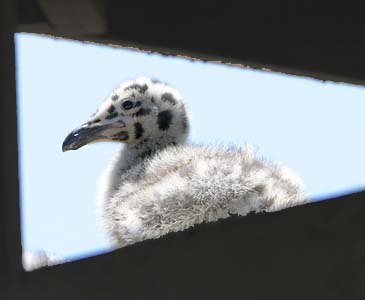

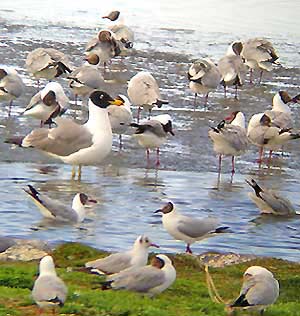
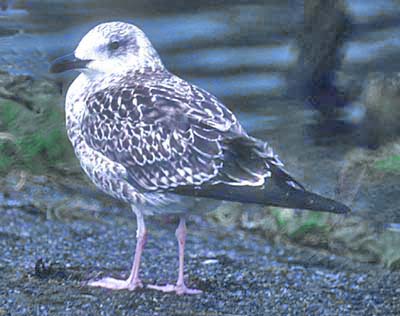
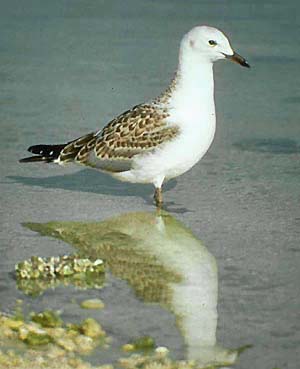
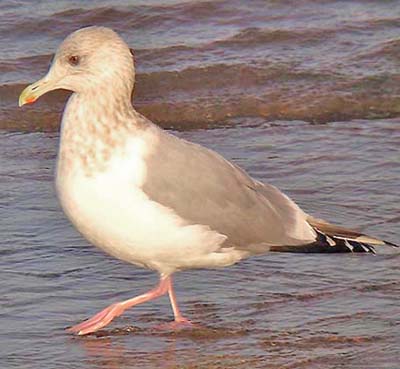
 One
of the most unusual gulls is the night-feeding Swallow-tailed Gull
(left; a first-year bird) of the Galapagos. It feeds primarily on
spawning squid (Belopolsky & Tsigankova 1985); note the black
eye-patch on the young bird (right) that is an adaptation for night
feeding (see Hailman 1964). We are only now learning that worldwide
climactic events, particularly irregular and major El Niños,
significant impact distribution in southern and tropical species.
During the great El Niño of 1982-83, for example, warm water
washed over the Peru Current and oceanic productivity dropped to nil.
All Swallow-tailed Gulls were dispersed (Alival et al. 1983), some
reaching to 42°S off Chile (Peter Harrison, in litt.) and another showing up in Panama (Reed 1988). Some must have dispersed far to west and north.
One
of the most unusual gulls is the night-feeding Swallow-tailed Gull
(left; a first-year bird) of the Galapagos. It feeds primarily on
spawning squid (Belopolsky & Tsigankova 1985); note the black
eye-patch on the young bird (right) that is an adaptation for night
feeding (see Hailman 1964). We are only now learning that worldwide
climactic events, particularly irregular and major El Niños,
significant impact distribution in southern and tropical species.
During the great El Niño of 1982-83, for example, warm water
washed over the Peru Current and oceanic productivity dropped to nil.
All Swallow-tailed Gulls were dispersed (Alival et al. 1983), some
reaching to 42°S off Chile (Peter Harrison, in litt.) and another showing up in Panama (Reed 1988). Some must have dispersed far to west and north.  The
search for vagrant gulls consumes "gulliphiles" and sometimes even more
ordinary birdwatchers. By 2004, the hunt was on for such vagrants to
North America as Slaty-backed Gull (right). There is now much information available on-line. Some important specialty gull identification sites are:
The
search for vagrant gulls consumes "gulliphiles" and sometimes even more
ordinary birdwatchers. By 2004, the hunt was on for such vagrants to
North America as Slaty-backed Gull (right). There is now much information available on-line. Some important specialty gull identification sites are: